Owls in Alaska – An In Depth Guide
Owls are quite a common sight all across Alaska. But there are quite a handful of species found in the state.
And if you are looking for a guide on the owls in Alaska then this is the article you are looking for.
In this guide on the airborne nocturnal found in Alaska, we will go through every species that are found there in detail. From their general details to behavioral patterns and interesting facts, everything will be discussed.
So, make sure to go through each section carefully.
Different Species of Owls Found in Alaska
10 species of owls have been monitored in Alaska either year-round or for a certain period in the years.
If you know how, when, and where to find them, then they can easily be spotted in Alaska. The owls that are found in Alaska are the following –
- Barred Owl
- Boreal Owl
- Great Gray Owl
- Northern Hawk Owl
- Great Horned Owl
- Northern Pygmy Owl
- Northern Saw Whet Owl
- Western Screech Owl
- Short Eared Owl
- Snowy Owl
| Name | Feather Color | Difference in Color | Mating Season | Construct Nests | Appearance in Alaska |
| Barred Owl | Molted brown & white | No | December to March | No | Year Round |
| Boreal Owl | Brown & white | No | February to July | No | Year Round |
| Great Gray Owl | Silver, grey, brown & white | Based on Sex | March to May | No | Year Round |
| Northern Hawk Owl | Deep brown & white | No | March to April | No | Year Round |
| Great Horned Owl | Molted brown, grey, black & white | Based on Region | January to February | No | Year Round |
| Northern Pygmy Owl | Brown, black & white | No | April to June | No | Year Round |
| Northern Saw Whet Owl | Molted brown & white | Based on Age | March to July | No | Year Round |
| Western Screech Owl | Red, brown & grey | Natural | February to May | No | Year Round |
| Short Eared Owl | Brown, black, beige & white | No | February to March | Yes | Year Round |
| Snowy Owl | Pale white, brown & black | Yes | December to March | Yes | Year Round/Migratory |
1. Barred Owl (Archilochus Colubris)
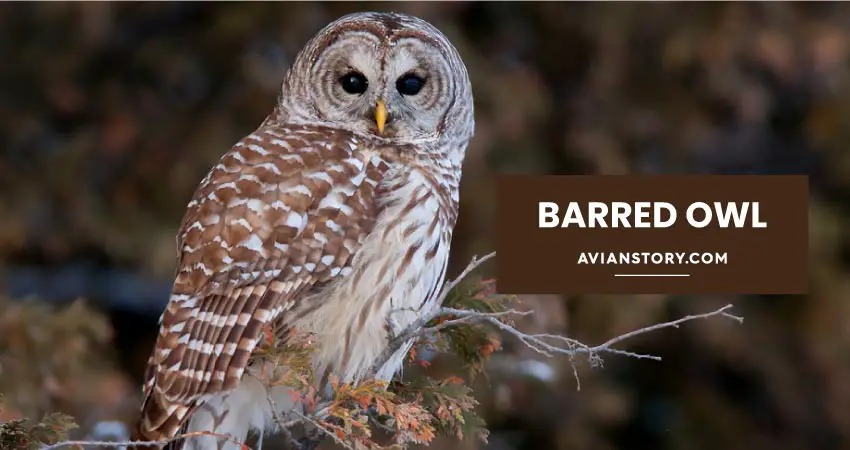
- Length: 16.9 inches to 19.7 inches
- Weight: 16.6 oz to 37 oz
- Wingspan: 39 inches to 43.3 inches
- Commonly Found In: Small Islands in the Gulf of Alaska
Barred owls aren’t quite a common sight in Alaska. They are generally sighted on the small islands that are located around the Gulf of Alaska.
Here are the behavioral and characteristic patterns found in Barred Owls.
Body Color and Feathers
There isn’t any color difference between male and female Barred Owls. Molted brown with white feathers are found all across the body of Barred Owls.
The majority of the feathers in the wings and tail are filled with brown feathers.
In the belly and chest areas, there are long vertical brown bars found other than the white feathers.
You won’t find that much difference in feather colors between adults and juveniles but the brown marks on the young ones aren’t as deep as the adults. There isn’t any color difference between male and female Barred owls.
Nest
Mixed forests that consist of large trees and open water bodies are the desired nesting location for Barred Owls. Old woodlands are preferred by these birds as well.
You will find them nesting in natural cavities. They will pick a cavity on an elevated location, around 20 to 40 feet.
These cavities are generally 10 to 13 inches in width and have an overall depth of 14 to 21 inches. But the depth can be much higher.
Barred Owls will often decorate their nests, sometimes they will add fresh leaves, lichens, and feathers inside the cavity. These birds are also known to use nests built by birds of prey and sometimes even man-made bird boxes.
Calling Sound
Like most other owls, the calling sound of Barred Owls is ‘Hoot’ but it sounds more like ‘Who cooks for you?’. They will make these hooting calls several times. Generally, around 7 to 9 notes.
Food Preference
Small animals from squirrels, mice, chipmunks, rabbits, voles, and songbirds to geese, reptiles, amphibians, and invertebrates all are on the food list of Barred Owls.
Sometimes, they will even feast upon fish. You will find these owls going against prey that are much larger than themselves often.
Barred Owls mainly do their hunting by perching but sometimes won’t hesitate to give a good chase too.
Mating Season and Reproduction
The mating season for Barred Owls begins around December and will end in March. A female bird will lay 2 to 4 white eggs and will incubate the eggs for a month or more.
Lifespan
Barred Owls are known to have a lifespan between 8 to 10 years. That being said, the oldest Barred Owls caught in the United States were 26 years & 7 months old.
Interesting Facts About Barred Owls
Here are some interesting facts about Barred Owl that will surprise you.
They Don’t Migrate
Migration is a big no for Barred Owls. They don’t move around much and as they are generally from the northern parts of the world, cold doesn’t bother them that much. And even if they move, they won’t move more than a few miles from their home.
Stores Their Food
Barred Owls will often store some of their food inside their nests or in the crook branches of the tree that they are living in. They generally do this so that they have a food source for emergency cases. This is highly witnessed during the winter.
Hunted By Numerous Predators
Life of Barred Owls is quite difficult as they often get hunted by different types of birds of prey, bands of small predators like crows, woodpeckers, songbirds, and raccoons.
But their most terrifying predator is none other than the Great Horned Owl.
2. Boreal Owl (Aegolius Funereus)
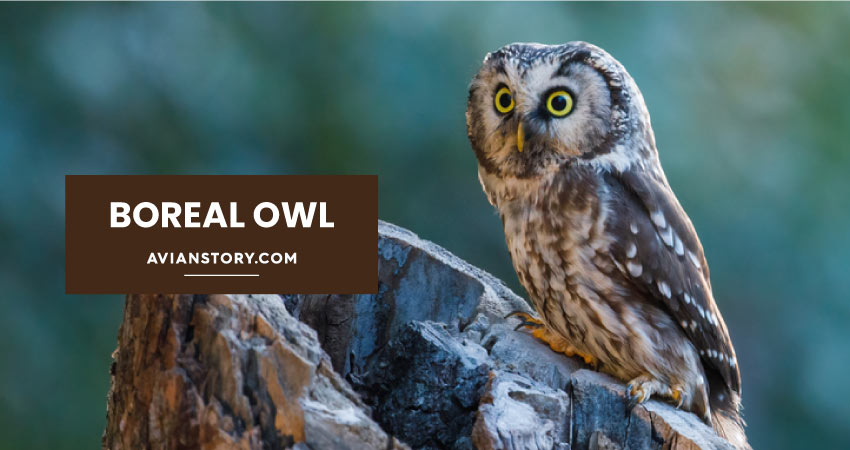
- Length: 8.3 inches to 11 inches
- Weight: 3.3 oz to 7.6 oz
- Wingspan: 21.6 inches to 24.4 inches
- Commonly Found In: All across Alaska
These owls are quite a common sight in Alaska but finding them can prove to be a bit difficult as these birds roost on a different tree every night.
These behavioral and characteristic patterns are shown by Boreal Owls.
Body Color and Feathers
Brown feathers are the base color for Boreal Owls. Over those brown feathers, there will be multiple white dots of different sizes.
These white feathers are especially prominent on the chest and underbelly zones of the bird. There isn’t any difference between male or female Boreal Owls, the same can be said for adult and juvenile Boreal Owls as well.
Nest
Conifer woodlands are the preferred habitat for these birds. They don’t focus on much when comes down to nesting. These owls will look for nest holes in old conifer trees and stay there.
Generally, it is the males that will look for nests. They usually find 4 to 5 nests in a preferred location and then let the female choose the one where they will mate.
Calling Sound
‘Hooot’ is the common calling sound for most owls and includes Boreal Owls as well. Their calls however are quite high-pitched and are longer than most other owl calls.
Food Preference
Small mammals like voles, mice, squirrels, bats small birds like robins everything can be on the diet list for Boreal Owls. Sometimes they will also hunt insects too.
Normally they hunt during the night and attack their prey up close with their talons. They have also been known to perch and spy on their target before striking.
Mating Season and Reproduction
Late February to July is the mating period for Boreal Owls. They will lay 3 to 5 white eggs. The mother will incubate the eggs for 26 to 33 days.
Lifespan
While Boreal Owls have an overall life expectancy of 16 years. The oldest one found in the states was just 8 years old.
This is mainly because these owls often get hunted due to their small size.
Interesting Facts About Boreal Owls
Here are some interesting facts about Boreal Owls
Distance From Partner
Boreal Owls are quite anti-social and it shows during their mating period, the female and male owls will only show up to the nest site for courtship and feeding.
Different Relationship Status in Different Regions
In Alaska and other parts of North America, Boreal Owls are monogamous while in parts of Europe, Boreal Owls follow polygamous relationships.
Only Defends the Necessary
Even though they have a small structure, they will viciously defend their nests, especially during mating season. But they only defend the nest. If the surrounding area is in danger, they generally don’t bother.
3. Great Gray Owl (Strix Nebulosa)

- Length: 24 inches to 33.1 inches
- Weight: 24.6 oz to 60 oz
- Wingspan: 53.9 inches to 60.2 inches
- Commonly Found In: All Across Alaska
If you imagine what an owl looks like, you will probably be thinking of a Great Gray Owl. These birds are found all across Alaska and are year-round residents of the state.
Here are the behavioral and characteristic patterns found in Great Gray Owls.
Body Color and Feathers
When it comes down to colors, you won’t find many differences apart from lighter and darker tones between male, female and juvenile Great Gray Owls.
The primary color of their feathers is a silver-grey mix. But they are heavily patterned with brown and white streaks and bars.
Nest
Great Gray Owls never build their nests. Instead, you will find them nesting on old nests of eagles or hawks.
Sometimes, they will even make a squirrel’s old nest their home if there is enough space for them. Often you will find them picking a nest that was made on an open wide tree.
During incubation, they might scratch their borrowed nest surface to make the process a bit more comfortable but they don’t go more than that to make a nest their own.
Calling Sound
The calling sound of Great Gray Owls is similar to a low-toned ‘Hooo Hooo’ sound. Generally, they will repeat this call for 8 to 12 times. You will hear them calling out during courtship and hunting.
Food Preference
Small animals like chipmunks, rabbits, voles, squirrels, and mice are the primary food choice for Great Gray Owls. But they are also known for going after songbirds, reptiles, and lemmings too.
These birds are silent hunters and will perch unnoticed until they have found their target. Generally, they will stealthily swoop down and pick their target up with their talons.
Mating Season and Reproduction
The mating season for Great Gray Owls is around March to May. Generally, Great Gray Owls, will lay 3 to 5 eggs in a season. The incubation is completely done by the female and it takes around a month or so for the eggs to hatch. The male bird will hunt and bring food for the female during this period.
Lifespan
Great Gray Owls have an overall lifespan of 28 years. But in the United States, the oldest Great Gray Owls that were caught were 18 years & 9 months old.
Interesting Facts About Great Gray Owls
Here are some interesting facts about Great Gray Owls that will surprise you.
Hunts During the Day
While most owls won’t hunt till it is night. Great Gray Owls are known to hunt during the day, especially in the winter. This behavior is also witnessed when it is their mating season.
High Force Generation
Great Gray Owls can generate quite a huge amount of speed even with their high weight. It is said that one Great Gray Owl was able to go through snow strong enough to handle a 176-pound man.
Large Appetite
These birds will eat around 7 to 8 vole-sized animals per day. And might look for a few more snacks afterward.
4. Northern Hawk Owl (Surnia Ulula)
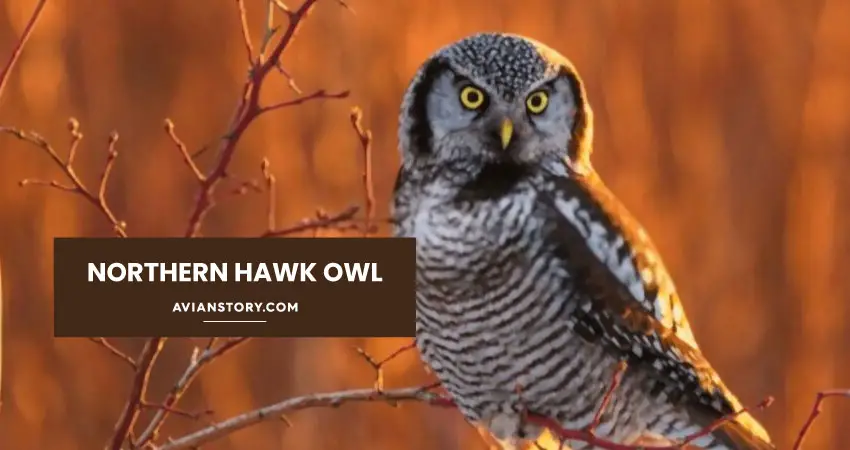
- Length: 14.2 inches to 17.7 inches
- Weight: 8.5 oz to 16 oz
- Wingspan: 27.9 inches
- Commonly Found In: Central & Southern Alaska
The Northern Hawk Owl is a common sight in the central and southern parts of Alaska. Coniferous forests on the mentioned areas, are where you will encounter them the most. Sometimes they are also found near urban areas but that is a bit rare.
These are the behavioral and characteristic patterns found in Northern Hawk Owls.
Body Color and Feathers
Similar to most other owls found in Alaska, there isn’t any significant color difference between male, female or juvenile Northern Hawk Owls.
These birds have deep brown feathers covering their body with white and brown spots and streaks coming out from here and there.
The chest and belly mainly consist of white feathers with brown streaks on top. There is no color difference among male, female or juvenile owls.
Nest
Coniferous forests are the most preferable location for Northern Hawk Owls. These birds don’t create their nests and will occupy the nest of woodpeckers or natural hollows generated on trees.
The sign of an active Northern Hawk Owl nest is that it will be filled with the feathers of the birds and remnants and furs of their prey. Both of the birds will look for a nesting place when the mating season begins.
Calling Sound
‘Huhuhuhuhuhuhuhu’ is the calling sound of Northern Hawk Owls. They will use this to communicate and interact with other birds, as well as threaten other owls and birds that enter their territories.
Food Preference
Small animals from voles, squirrels, rabbits, mice, chipmunks, and songbirds are on the list of food for Northern Hawk Owls.
Leaping off from perch is the general hunting style for these birds. Sometimes they will fly low and then swoop up their prey.
Mating Season and Reproduction
The mating season for Northern Hawk Owl begins around March and ends around April. Northern Hawk Owls lay about 5 to 9 eggs in a breeding year.
The female bird will take charge of the incubation process which is around 25 days to a month.
Lifespan
Northern Hawk Owl can live up to 16 years. But most generally don’t make that far due to harsh living conditions and hunters.
Interesting Facts About Northern Hawk Owl
Here are some interesting facts about Northern Hawk Owl that will surprise you.
Superior Eyesight
These birds can find targets from half a mile away and even though the lowest amount of light conditions.
Invade Other Areas
If there is a decline in mammals in the area where these birds are living then they will wander to the surrounding areas and will create a feeding ground there. These invasions often lead to conflict with other birds.
Tolerates Others
Unlike other owls, these birds don’t care if some other bird or owl is roaming in their area. But if any get close to their nests, they will become extremely aggressive.
5. Great Horned Owl (Bubo virginianus)
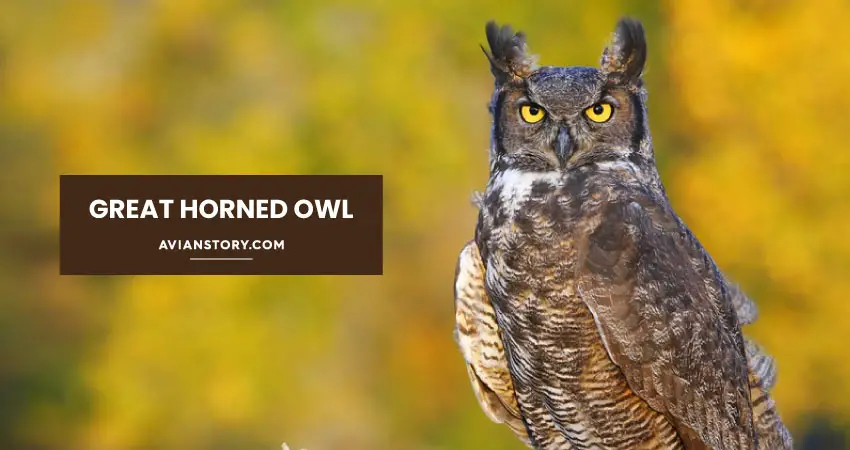
- Length: 18.1 inches to 24.8 inches
- Weight: 32.1 oz to 88.2 oz
- Wingspan: 39.8 inches to 57.1 inches
- Commonly Found In: All across Alaska
Great Horned Owls are one of the most well-recognized owls on the planet. They are also found all across Alaska. But not too much in northern Alaska though. These birds don’t like cold weathers. That is why many migrates when winter comes.
Here are the behavioral and characteristic patterns found in Great Horned Owls.
Body Color and Feathers
There is color varies depending on the region of the Great Horned Owl. In Alaska, you will encounter Great Horned Owls with mottled grey and brown color mixed owls.
But there are also Great Horned Owls with red-brown feathers covering the body with white and black spots and steaks popping off vertically. The color between males and females is identical.
Nest
Mixed forests with large trees near open sources of water are the desired nesting location for Great Horned Owls.
These birds also don’t make their nests but rely on nests made by eagles and hawks. They do bring in leaves and wooden sticks to make the nest a bit of their own.
Calling Sound
The calling sound of Great Horned Owls is ‘Hoot’ but it sounds more like ‘hoo-hhooot’ rather than a simple ‘Hoot’. You will hear them rapidly hooting 8 to 10 times.
Food Preference
When it comes down to food preference, Great Horned Owls have one of the most diverse pallets in the animal kingdom. Small rodents to medium-sized mammals are part of their food list.
These birds will hunt on rodents, hares, scorpions, skins, geese, rabbits, voles, moles, gophers, squirrels, chipmunks, woodchucks, dogs, bats, cats, ducks, other owls, small to mid-sized hawks, crows, ravens, doves, reptiles, fish and more.
Perching is their preferred style of hunting but they have also been known to chase down their prey.
Mating Season and Reproduction
The mating season for Great Horned Owl starts in January and finishes in February.
You can expect a female Great Horned Owl to lay 2 to 5 white eggs. The incubation period is 28 to 35 days and is solely done by the female.
Lifespan
The general lifespan of Great Horned Owls is 28 years old.
Interesting Facts About Great Horned Owl
Here are some interesting facts about Great Horned Owls.
Fierce Hunter
Great Horned Owls are extremely fierce and won’t hesitate to take down large animals. They have been known to fight ospreys, peregrine falcons, and other large-sized owls.
Smaller Body Larger Voice
Male Great Horned Owls, while smaller have a larger vocal presence than their female counterparts.
Picks the Nest Sites Early
Sometimes, Great Horned Owl pairs will point out their preferred nesting spot even before the mating season begins. You can find some roosting there for 6 to 7 months before the beginning of their breeding period.
6. Northern Pygmy Owl (Glaucidium Californicum)
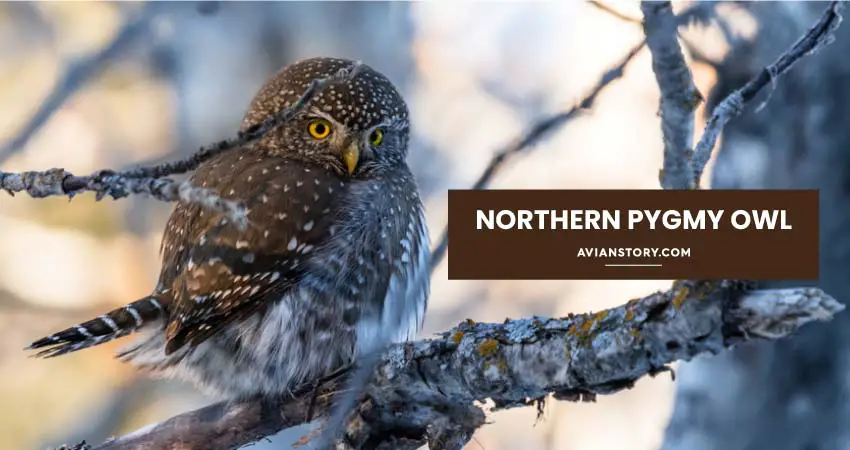
- Length: 6.4 inches to 7.1 inches
- Weight: 2.1 oz to 2.5 oz
- Wingspan: 14.5 inches to 16 inches
- Commonly Found In: Southern Alaska
Northern Pygmy Owls are one of the smallest owls you might find in Alaska. While they are a common sight in the western part of the US, you will generally find them in the south of Alaska. They are quite a rare sight in other zones.
The following are the behavioral and characteristic patterns found in Northern Pygmy Owls.
Body Color and Feathers
There isn’t any color difference between male and female or juvenile owls. Brown is the main color that is on the back, sides, and tail with white spots all over the body.
The front of the body is filled with white here with vertical strips of brown feathers in a repeated manner.
Nest
Northern Pygmy Owls don’t build their nests. They will either nest in natural holes in trees or just make use of old homes made by woodpeckers.
Northern Saw Whet Owls also don’t do any customization to the cavity. They just use whatever they find for themselves.
Calling Sound
Like most other owls, the calling sound of Northern Pygmy Owls is ‘Hoot’ but they do it at a very fast pace and repeat constantly. Sometimes it even sounds like ‘Whet’ than ‘Hoot’.
Food Preference
Small birds are the preferred food choice for Northern Pygmy Owls. Their diet includes hummingbirds, sparrows, and warblers.
Northern Saw Whet Owls also pick up mammals like voles, chipmunks, and shrews sometimes. They are also open to insects like beetles, crickets, and grasshoppers.
Reptiles like lizards are also on their food list.
Mating Season and Reproduction
April to the end of June is the mating period for Northern Pygmy Owls. They lay around 2 to 7 small white eggs followed by an incubation period of 28 days solely done by the female.
Lifespan
Northern Pygmy Owls have a lifespan of 6 to 7 years. They often don’t make that far as they get hunted by other birds of prey.
Interesting Facts About Northern Pygmy Owls
Here are some interesting facts about Northern Pygmy Owls that will surprise you.
Not Nocturnal
Most of their hunts will be done in daylight. Unless they have no other option they won’t look for food after the sun sets.
Stores Food
Northern Pygmy Owls will store some leftover prey inside their nests or tree barks. This allows them to have constant food options and not go out hunting in the dark.
Raises Tuff in Danger
If they are facing any sort of danger, these birds will raise their tuffs which otherwise isn’t visible at all. They generally do this when they are being hunted by larger birds.
7. Northern Saw Whet Owl (Aegolius Acadicus)

- Length: 7.1 inches to 8.3 inches
- Weight: 2.3 oz to 5.3 oz
- Wingspan: 16.5 inches to 18.9 inches
- Commonly Found In: South-eastern and South coast of Alaska
Northern Saw Whet Owls are widely found on the southern coasts of Alaska. They are also witnessed year-round in the Southeastern part of the state as well. But finding them in the central and northern parts are difficult. These owls prefer dense forests with open water sources.
The following are the behavioral and characteristic patterns found in Northern Saw Whet Owls.
Body Color and Feathers
You will find a bit of color difference between juvenile and adult Northern Saw Whet Owls.
The adults have mottled brown feathers covering the majority of the back and the wings along with the head. There are white spots all over too.
The underneath is filled with white feathers mostly but there is a mix of brown on the sides.
As for the juvenile Northern Saw Whet Owls, they have darker brown colored feathers with beige underneath. But there ain’t no color difference between male and female owls.
Nest
Mixed forests are the preferred nesting spots for Northern Saw Whet Owls. These owls don’t build their nests like most other owls on this list.
They will either occupy the nests of woodpeckers or just pick natural tree holes. Mainly the females take charge of finding a nest.
Calling Sound
The calling sound of Northern Saw-Whet Owls is similar to high pitched ‘Too-Too’ sound which they repeat rapidly.
Food Preference
They mainly hunt from perching. Small animals like squirrels, mice, chipmunks, rabbits, and voles are on the food list of Northern Saw-Whet Owls.
They also hunt small birds like sparrows, warblers, and robins. Insects like moths and grasshoppers are also on their preferred list.
Mating Season and Reproduction
The mating season for Northern Saw Whet Owls begins around March and will end in July. A female Western Screech Owl will lay 4 to 7 smooth white eggs and will incubate the eggs for 26 to 29 days.
Lifespan
Northern Saw Whet Owls are known to have a lifespan of 7 years. That being said, the oldest Northern Saw Whet Owls caught in the United States were 9 years & 5 months old.
Interesting Facts About Northern Saw Whet Owls
Here are some interesting facts about Northern Saw Whet Owls.
Food Abundance Leads to Multiple Partners
In a mating period, if the male Northern Saw Whet Owl finds an abundance of prey to hunt then they will indulge in polygamy while the females will still pursue monogamy.
One Nest at a Time
Northern Saw Whet Owls don’t use the same nest twice for breeding. They will look for new nests each mating season.
Keeps the Nest Clean
The female Northern Saw Whet Owl often keeps the nest neat by taking out remnants of food and changing the leaves and twigs regularly.
8. Western Screech Owl (Megascops Kennicottii)
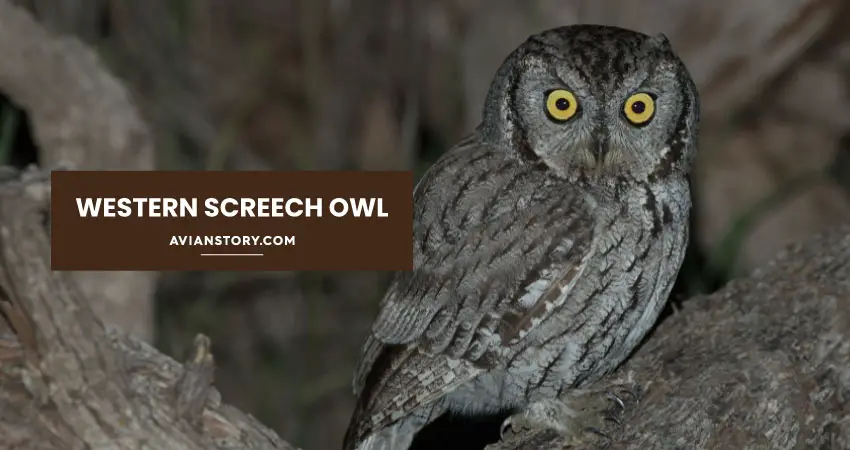
- Length: 7.5 inches to 9.8 inches
- Weight: 3.5 oz to 10.8 oz
- Wingspan: 21.6 inches to 24.4 inches
- Commonly Found In: South & South-East Alaska
These birds aren’t common in the central part of Alaska but you can easily spot them in the South and the South-Eastern forests in Alaska. Most of them likes dense forests and mountainsides.
The following are the behavioral and characteristic patterns found in Western Screech Owls.
Body Color and Feathers
These birds come in three different primary colors: reddish-brown, brown, and grey.
There are also white and black feathers involved throughout the body which look more like small vertical stripes than anything else. There is no color distinction between male and female juvenile owls.
Nest
Western Screech Owls also can’t make their nests. So, they will find empty homes for woodpeckers and decorate the cavity to their preference.
As they tend to use a nest for several years, they do take care of it daily. Most of the time, it is the male bird that finds a nest in its breeding period.
Calling Sound
Like most other owls, the calling sound of the Western Screech Owl is ‘Hoot’ but it sounds more like ‘Hhhooootttt’. They repeat it twice or thrice at best. Normally a pair will communicate with each other while they are hunting or in courtship. If they are agitated then they will let out a more high pitched screech.
Food Preference
Squirrels, mice, chipmunks, rabbits, voles, shrews, grasshoppers, moths, and crayfish are the most preferred choice of Western Screech Owls. Their food choices change over the seasons and also depend on the availability of the said prey as well.
Perching is their go-to hunting style but they have been known for chasing airborne targets too.
Mating Season and Reproduction
Western Screech Owls will start their mating season around the end of February and finish it in the middle of May.
The females will lay 2 to 6 white eggs which will be incubated by both parents. But in most cases, the female will try to do it all by herself.
Lifespan
13 years is the general life expectancy for Western Screech Owls. That being said, the oldest ones found in the US were 14 years & 4 months old.
While in captivation one pair lasted for 19 years.
Interesting Facts About Western Screech Owl
Here are some interesting facts about Western Screech Owl.
Directs the Female to the Nest
Sometimes to guide the female to a nest, a male Western Screech Owl will bring food with him and then make the female bird follow the food to the nest.
Perfect Camouflage
Western Screech Owls will hide by putting their head under their wings. Their unique colored feathers then allow them to blend in with nature.
This helps them to hide from predators and stealthily attack their prey.
Aren’t Afraid of Larger Animals
These owls can be fearless if they feel like it. They have been known to fight against birds and animals twice larger than them.
That’s why you will often find them hunting on cottontail rabbits which are quite larger than the size of Western Screech Owls.
9. Short-Eared Owl (Asio flammeus)
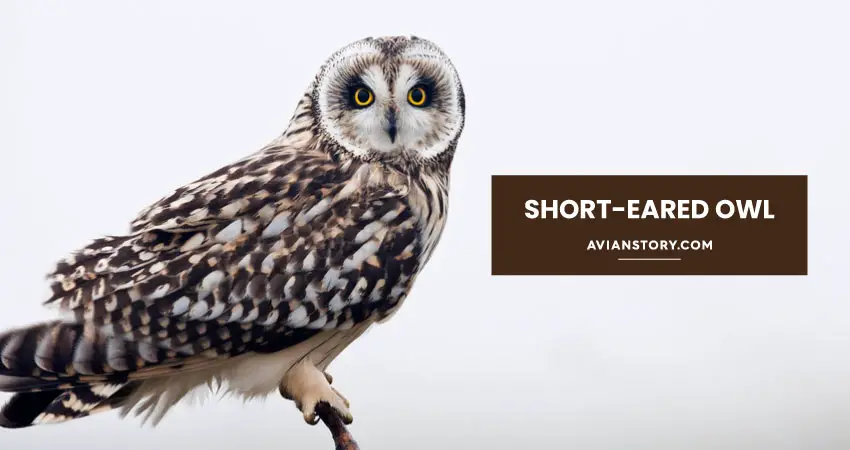
- Length: 13.4 inches to 16.9 inches
- Weight: 7.3 oz to 16.8 oz
- Wingspan: 33.5 inches to 40.5 inches
- Commonly Found In: All Across Alaska
Short Eared Owls are a common sight in Alaska. They are spread across the forests and mountain areas of Alaska. Sometimes they are also spotted in urban areas.
Here are the behavioral and characteristic patterns found in Short Eared Owls.
Body Color and Feathers
Both adults and juveniles look the same for this species. A mix of black and beige-brown colored feathers covers the entire body of the Short-Eared Owl.
White feathers are popping off from there and there but it is mainly the color mix that is seen throughout. The feathers underneath are completely white with a hint of brown here and there.
There is also no difference between male and female Short Eared Owls.
Nest
Dry locations with low plants and grass are the preferred location for Short Eared Owls to nest. These are one of the few species of owls that can construct their nests.
It looks like a bowl on the ground lined with grasses and feathers. The nests are usually 2 inches in height and 10 inches wide.
Calling Sound
Short Eared Owls tend to make the casual ‘Hoot-Hoot’ noise that owls are famous for. But theirs is a bit like a screech than other owls. These high-pitched calls can be heard from a good distance. They generally call out during hunting and nighttime.
Food Preference
Mice and voles are the two most preferred food choices for Short Eared Owls. They will also hunt bats, rats, muskrats, weasels, gulls, songbirds, and shorebirds.
While hunting, they generally chase their prey from a close angle.
Mating Season and Reproduction
The last days of February to the entirety of March is the mating period for Short Eared Owls. They will lay around 3 to 11 white-colored eggs which the female solely incubates for 24 to 37 days.
Lifespan
The lifespan of Short Eared Owls is between 4 to 12 years. Most Short-Eared Owls won’t reach 10 or 12 years as they become prey of other raptors and predators. Illegal hunting also plays a role here.
Interesting Facts Short-Eared Owl
Here are some interesting facts about Short-Eared Owl.
Traveling Lon Distances
Short Eared Owls have been seen to cross large distances without taking a break.
There have been cases where they have reached ships in the deep sea just from the shore.
Defecate to Protect the Eggs
Females don’t leave their nests once the eggs have been laid. But if they are forced to, they will defecate on the eggs so that the smell prevents anyone from reaching towards the eggs.
Picky Eater
If they have hunted birds, then Short-Eared Owls will take away the wings first and then feast upon them. They won’t eat a bird if the wings are still attached.
10. Snowy Owl (Bubo Scandiacus)
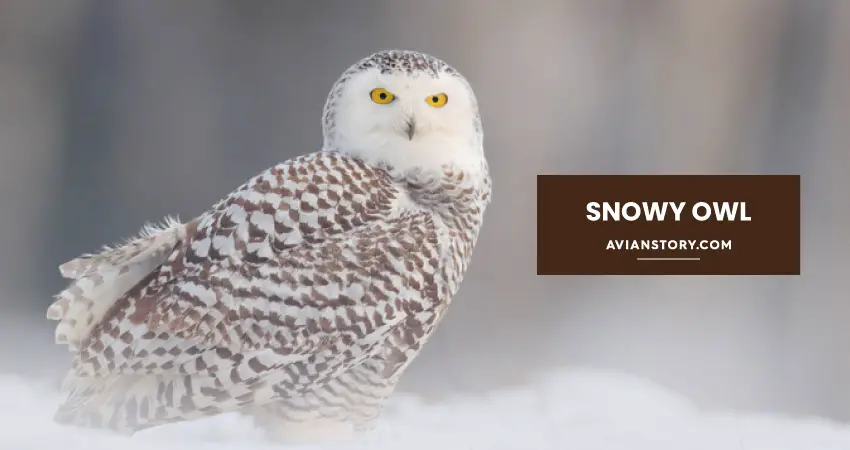
- Length: 20.5 inches to 27.9 inches
- Weight: 56.4 oz to 104.1 oz
- Wingspan: 49.6 inches to 57.1 inches
- Commonly Found In: All around Alaska, especially in Northern Alaska
Snowy Owl is a common sight in Alaska. They are found in the state yearlong but prefer a more chilled weather. So, they can be commonly seen in the northern parts of the State compared to the central parts.
Here are the behavioral and characteristic patterns found in Snowy Owl.
Body Color and Feathers
As the name suggests, the body of these birds is filled with snowy white feathers.
But there is a slight distinction between male and female birds. There are brown and black markings on the white feathers of Snowy Owls.
In males, the color is very pale while in females it is deeply dense.
Nest
These owls also build their own nest. The male selects the territory while the female selects the location of the nest.
Their nest is made on the ground where the female will make a shallow hole or hollow and shape it with their wings. The creation process takes a bit of time but they use one nest for several years.
Calling Sound
Snowy Owls make rasping and low-toned ‘Hoot’ sounds. They will slowly repeat the hoots 5 or 7 times.
Food Preference
Lemmings along with other small mammals are the primary food for Snowy Owls.
They also hunt small birds like waterfowl or ptarmigan. Their food list also consists of rabbits, rodents, hares, weasels, squirrels, seabirds, geese, ducks, and more.
Mating Season and Reproduction
May to September is the mating season for Snowy Owls. They lay 3 to 11 eggs which the female will incubate for more than a month.
Lifespan
Snowy Owl have a life expectancy of 10 years. But the oldest one caught in the US was 23 years and 10 months old.
Interesting Facts About Snowy Owls
Here are some interesting facts about Snowy Owls.
Part of European Culture
Snowy Owls made their way into the prime of European culture in ancient times.
This can be seen in the cave pictures that were found there. Almost any painting that described a story had a Snowy Owl in it.
Some Migrate Some Don’t
Many Snowy Owls won’t migrate to warm environments during the winter and will stay in their breeding grounds all year long. This is due to these birds have a higher cold resistance than most other owls.
They Don’t Like to Move
These birds don’t like the concept of flying too much. That is why you will find them just sitting in a spot for hours.
But don’t think that they can’t handle themselves in the air. Because they are one of the most agile owls in the world even if they have a higher weight than most other species.
Final Thoughts
Alaska is the land of owls, and if you have come this far in this guide then you already know all the details regarding the owls in Alaska. So, make sure to use this guide when you are looking for them in the frozen north!
Owls Found in Other States:
References:
Feature Image Credits: Gus Garcia, Shutterstock

